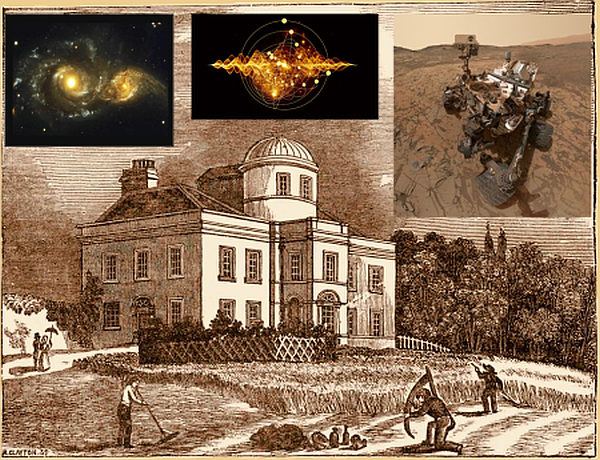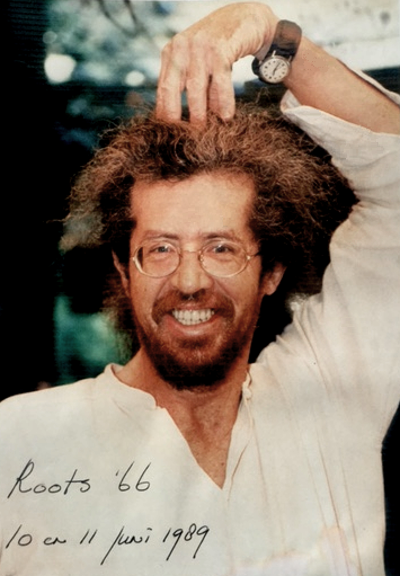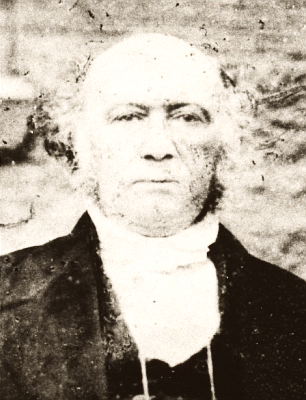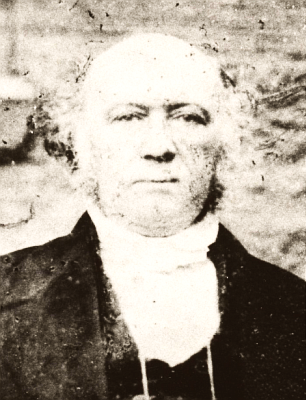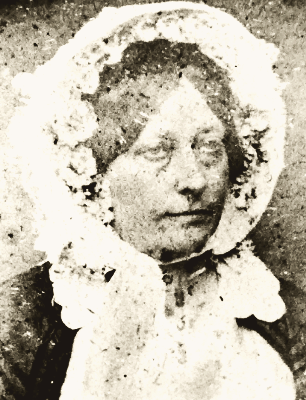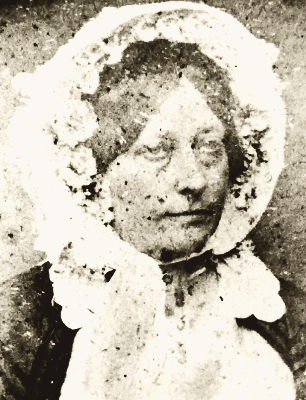 This work is licensed under a CC BY 4.0 International License
This work is licensed under a CC BY 4.0 International License
Contact
This page contains anything not at home in the other pages,
from nineteenth century Dublin and Seti to Mars and the Universe. From subjects belonging to Hamilton’s story, or my own interests and doings.
Emile Domis (1942-2002)
to whom I dedicated my AVM essay.
The Great Conjunctions of Jupiter and Saturn
—
13 October 2020
Observations in 1821 and 2020, and what it would have been in -1792
On 14 July 1821 Sir William Rowan Hamilton (1805-1865), or William Hamilton as he was called then, wrote a letter to his sister Eliza, about an observation he had made in Dublin from the house of 'Cousin Arthur' (first cousin once removed), of an occultation of a fixed star by the moon.
"Cousin Arthur procured me a good telescope from Mr. Mason the optician, with which I sat up on Saturday night, the 16th of June, till three o’clock the following morning, observing the moon and planets. That morning [...] I saw the planets Jupiter and Saturn in the east, remarkably near each other. Their conjunction took place on the 19th; the ring was very plain."
Today is 17 December 2020, and last week a colleague, Rob van Gent, had told me that it was the time of one of the great conjunctions of Jupiter and Saturn which happen every twenty years, and that this year is a special occasion because it will be the closest conjunction since 1623, or, because that conjunction was hardly visible due to its proximity to the sun, since 1226. This year it also coincides with the winter solstice.
Somewhat later, I realized that I had read that in 1821 Hamilton had seen Jupiter and Saturn “remarkably near each other,” and when I told Rob that that had been on 17 June he told me that two days later that conjunction had reached its minimal distance, as Hamilton had written indeed. I then asked him if he knew about a table showing Hamilton’s time, and he answered that he would make one. Rob made the table according to the DE431 ephemeris and using Aldo Vitagliano’s SOLEX software. (Update: because of developments I moved the tables, for dual and multiple conjunctions, down.)
In his letter to Eliza Hamilton mentioned that the conjunction of Jupiter and Saturn would take place on 19 June 1821, and in the tables it can be seen that this is correct. There were in fact two conjunctions that year, one on 19 June and another on 6 December. In the tables it can be seen that the one with the smallest distance was the conjunction of 19 June but Hamilton could not see it at the time of minimum; it happened at 14h18 Dublin mean time (UTC-25 minutes). He will have been able, if the weather allowed, to see the one in December, that one happened at 23h45 Dublin time. In his letter to Eliza Hamilton also mentioned that on 17 June the ring of Saturn had been very plain, which gives an idea about how well he could see the planets.
Assuming that the tables are still reliable for four thousand years ago, which they do seem to be,* one of the years in the tables stands out. In the year -1792 both the minimal distance between Jupiter and Saturn was the smallest of the period we looked at, -2000 to +4000 (5 MB, sorted on minimal distance), and the visibility was the best because it happened at the largest elongation, ie., distance from the sun. It did not happen simultaneously; on 1 May -1792 at 03h24 the minimal distance was the smallest, only 0.021 degrees, while on 19 January -1792 at 16h32 the elongation was the largest, 178 degrees. Nevertheless, with the very close conjunction of October -1793 it is the most close triple conjunction in this six thousand year period. It is unfortunate that we were not there to watch this extreme event, although we are fortunate that it can now be simulated. But if people then saw it, and without our light pollution they had very good views on the skies, they will have wondered what was happening. It would be great to know what they thought about it, and if traces of their conclusions still exist.
* According to the Jet Propulsion Laboratory, the planetary ephemeris DE431 “covers JED -3100015.5, (-13200 AUG 15) to JED 8000016.5, (17191 MAR 15),” making, as an understatement, -1793 and -1792 quite within its range.
A nice Hamilton twist here is, and I only found it while I was looking for a link to the ephemerides, that for reading them SPICE is recommended, of which we know that it contains quaternions. I then searched whether also Stellarium uses SPICE and therefore quaternions, for which I did not find an answer. But what I did find was that in the configuration window of Stellarium’s version 0.15.0, the one which is used here, the option of using the ephemerids DE430 (high accuracy) and DE431 (long-time data) is offered as experimental; if not installed or activated the program will use VSOP87/ELP2000-82B. This version 0.15.0 was the first version in which the ephemerids could be used; what a coincidence that it was also the last one with the time plugin I needed for Hamilton’s Dublin time. Suddenly Hamilton showed up again in a for me completely unexpected corner.
Visibility in 2020, as seen from the Netherlands
Even though at many locations the conjunction at minimal distance cannot be seen, Jupiter and Saturn do not move so fast that seeing them at almost the time of minimal distance woud be very different. Every day around minimal distance, clouds aside, is good for an exceptional and impressive view. For the Netherlands it will hold for Monday 21 December, the day of minimal distance which will occur at 18h20m58s UT, that sunset is at 16h29 UTC+1; at that time Jupiter and Saturn are in the south-southwest, at an altitude of about 14 degrees. Civil twilight will be at 17h10 with the planets at 11 degrees altitude, nautical twilight at 17h54 with the planets at 7 degrees altitude in the southwest, at astronomical twilight at 18h36 they will be at 2 degrees altitude. I made two Stellarium screenshots for Utrecht at the start of nautical twilight, one for a light polluted city view, and one for a clear sky if that can be found.
Stellarium screenshots
The settings for the Stellarium screenshots below are based on the following considerations, where a quest for beautiful images was combined with good astronomical views. Clicking on the images gives ones with a (somewhat) higher resolution.
1st row -- Happily, this afternoon at 17h50 UTC+1 on 17 Dec 2020, I could see the conjunction of the moon, Jupiter and Saturn from my flat in Utrecht. I was surprised that with just binoculars I could see one of the moons of Jupiter, but Stellarium showed that Jupiter’s moons Europe and Ganymede were very close together, greatly enhancing my chance to see something. I made a screenshot of a Stellarium simulation of what I had seen without the binoculars; this screenshot, the first of the seven screenshots shown below, has a smaller field of view than the other ‘overviews’ because the simulated moonlight interfered in a more zoomed-out view. It resembles what I saw quite good.
Note added 20 December 2020. I just saw Jupiter and Saturn again after two cloudy days; they are now much closer than I had expected! Saturn even becomes difficult to see in my light polluted surroundings.
Note added 21 December. Completely overcast. No conjunction for us alas.
In many of the news items today it was mentioned that this was the closest conjuction since 800 years, 1226, which is not true, it was since 1623. It is the closest one with a good visibility since 800 years. The conjunction in March 2080, often mentioned now as the next conjunction, will be a very close one, even closer than this one was. But it is not the next conjunction. That will occur in October 2040, yet its minimal distance will be larger.
2nd row -- In the above mentioned letter to his sister Hamilton wrote that on 17 June 1821 around 2h15 (Dublin time) he had been looking at the upcoming occultation of a star by the moon of which he could not see the exact moment he had calculated, 2h24, because of an obstruction by a wall. He also mentioned that he had seen Jupiter and Saturn “remarkably near each other.” The sun would rise at 3h30 and Hamilton went to bed at three o’clock; he thus may have seen the conjunction around 2h45 Dublin time. For the screenshot I chose less light pollution than Dublin has now, and the time settings were set to Dublin mean time, which was UTC-25m. Hamilton could not see the conjunction at the time of minimal distance, which was during the day at 14h18 Dublin time. The second screenshot in this row shows the time of minimal distance of the second close conjunction that year which occurred on 6 December 1821 at 0h10 UTC, thus on 5 December 23h45 Dublin time. The moon was at 86%, which dependent on the weather may have interfered, or enriched the view.
3rd row -- Moanda in Gabon was chosen for Monday 21 December 2020 because the conjunction can very well be seen there, and the altitude fits in nicely with my choice of screenshot dimensions. From the Lofoten the view gave the most beautiful configuration in my choices for the screenshots, yet I had to turn off the landscape setting because in fact it will not be possible to see it on Monday.
4th row -- For the smallest minimal distance between -2000 and +4000 I chose Charlotte in North Carolina because it could easily have been seen there in -1792, again in the for me convenient altitude. But in -1792 there was no light pollution, therefore I set that setting, and the fog, to the lowest one possible, and coloured the farm lights in the landscape setting a bit, hoping they would look like campfires. The time zone is UTC-5, therefore the date of minimal distance, as seen from our time-perspective, was 30 April. Finally, I showed the smallest distance in -1792 from Utrecht again; I liked the idea that it showed a configuration fitting in really beautifully with the screenshot dimensions. The configuration surpassed all my expectations; a moon of Jupiter apparently being closer to Saturn and vice versa is a view we will not see in our lifetimes, alas.
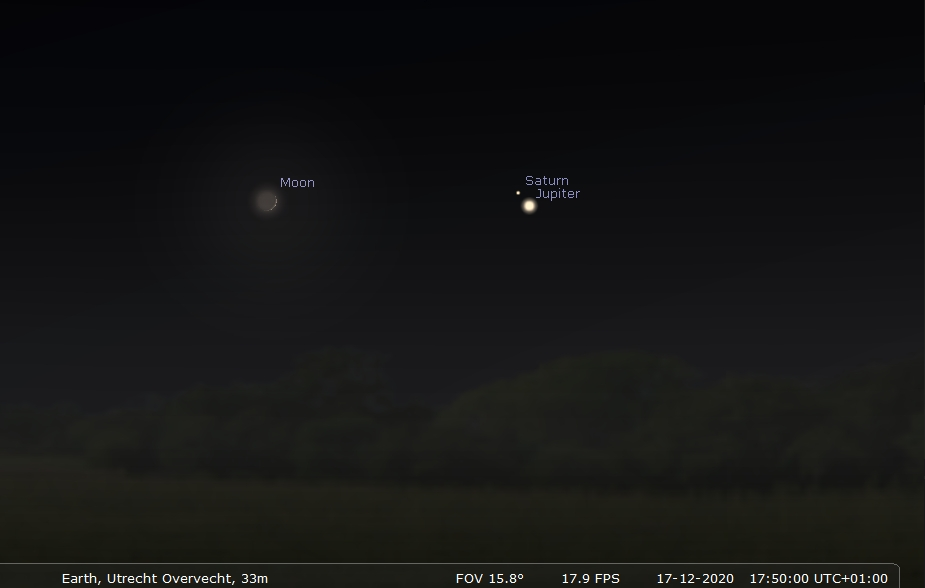
In the Netherlands Jupiter and Saturn cannot be seen at the time of minimal distance 2020. It was, nevertheless, a splendid sight seeing them in the evening sky, here simulated four days before minimal distance, and almost exactly as I saw it.

Hamilton, then 15 years old, saw a conjunction of Jupiter and Saturn in the night of 16/17 June 1821, shortly before sunrise. In these two prints the field of view is the same, to be able to compare the views.

It is not known whether Hamilton also saw this conjunction, but assuming that he knew about the conjunctions he may also have observed this much more favourable one, if the moon did not interfere too much, in December 1821.

The conjunction at the time of minimal distance in 2020 can be seen from for instance Gabon, time zone UTC+1. In again the same field of view the planets seem so close-by that their names intertwine.

The 2020 minimal distance cannot be seen from the shown location, the Lofoten, UTC+1, yet it gave the most beautiful composition in the screenshot.
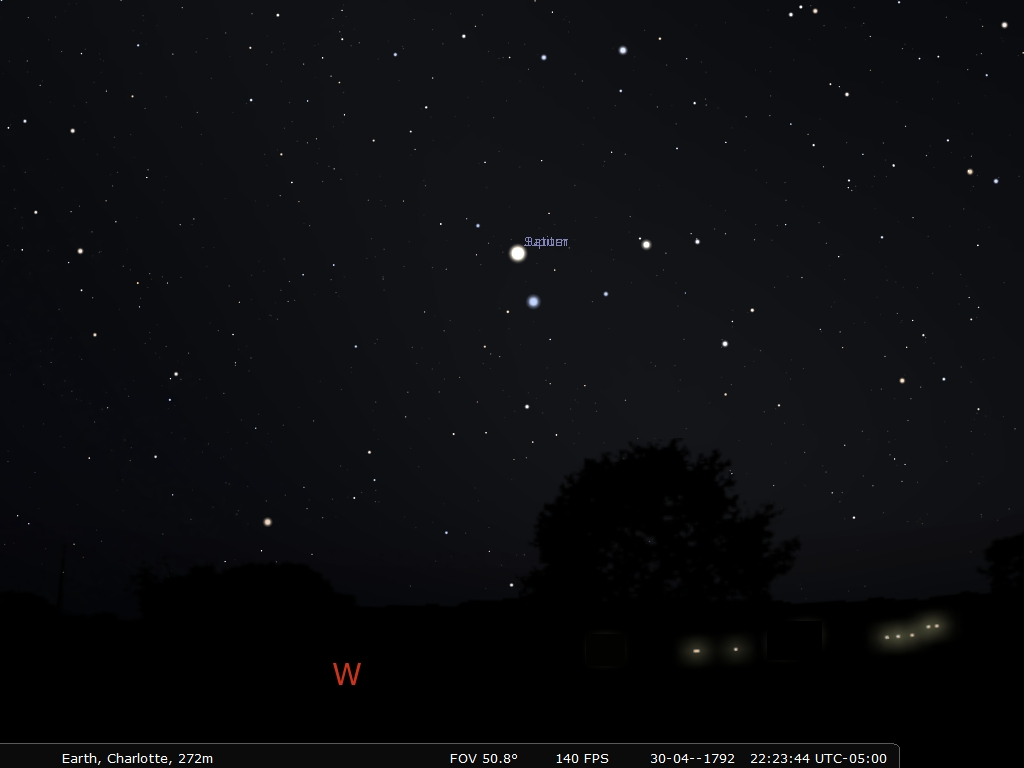
At the time of minimal distance in May -1792 this conjunction could not be seen in Europe, but it could in for instance Charlotte, time zone UTC-5. The bright star just below Jupiter and Saturn is Regulus, the main star of Leo.

Zooming in it appears that in May -1792 Jupiter and Saturn could have been seen so close together that Saturn’s moon Titan seemed to be closer to Jupiter than to Saturn, vice versa for Jupiter’s moon Callisto, and Io almost perfectly in-between.
Updated 4 Jan 2021 -- In the days around the turn of the year Aldo Vitagliano updated his Solex program.* Also, only having been interested in beautiful views I had not realized that there is a special definition for a conjunction; I here use it for planets being apparently very close together. From Wikipedia: “a conjunction occurs when two astronomical objects [...] have either the same right ascension or the same ecliptic longitude.” It meant that with choosing conjunctions (/C) in the Solex settings I excluded situations in which the planets were close but did not reach the same right ascension or longitude. As an example, Vitagliano explained: “For Jupiter-Saturn in December 1821, there actually was no ecliptic conjunction. Jupiter came close to Saturn while both planets were in retrograde motion, but never got to the same longitude, turning back to direct motion before reaching Saturn. If you run the search with the /C option, you are searching for conjunctions, not for the minimum angular distance. So that’s why the (pseudo)conjunction is [...] not found with the /C option.”
I therefore made new runs; the dual conjunctions without the /M (multiple) or /C option, and the multiple conjunctions with only the /M option. I made large ones for -4000 to 8000, and smaller ones for -2000 to 4000. With the separation between the two involved planets less than 15 degrees Dual conjunctions 12000 yrs (23 MB), idem Dual Conjunctions 6000 yrs (12 MB). With the separation between the two outer planets less than 40 degrees Multiple Conjunctions 12000 yrs (11 MB), idem Multiple Conjunctions 6000 yrs (5 MB). Because the files for dual conjunctions are so large I also made one only containing info for the minimal distance and elongation, Dual Conjunctions 6000 yrs min dist & visibility (5 MB).
* One of the settings in the program is Delta T. For what that is see Rob’s page Delta T: Terrestrial Time, Universal Time and Algorithms for Historical Periods.
The tables are read-only, but when saved the copies can be used freely. Legends are included. They show some very nice surprises such as two complete occultations of Saturn by Jupiter, one in -6856, and one in 7541.

A conjunction of Jupiter and Saturn in -6856.
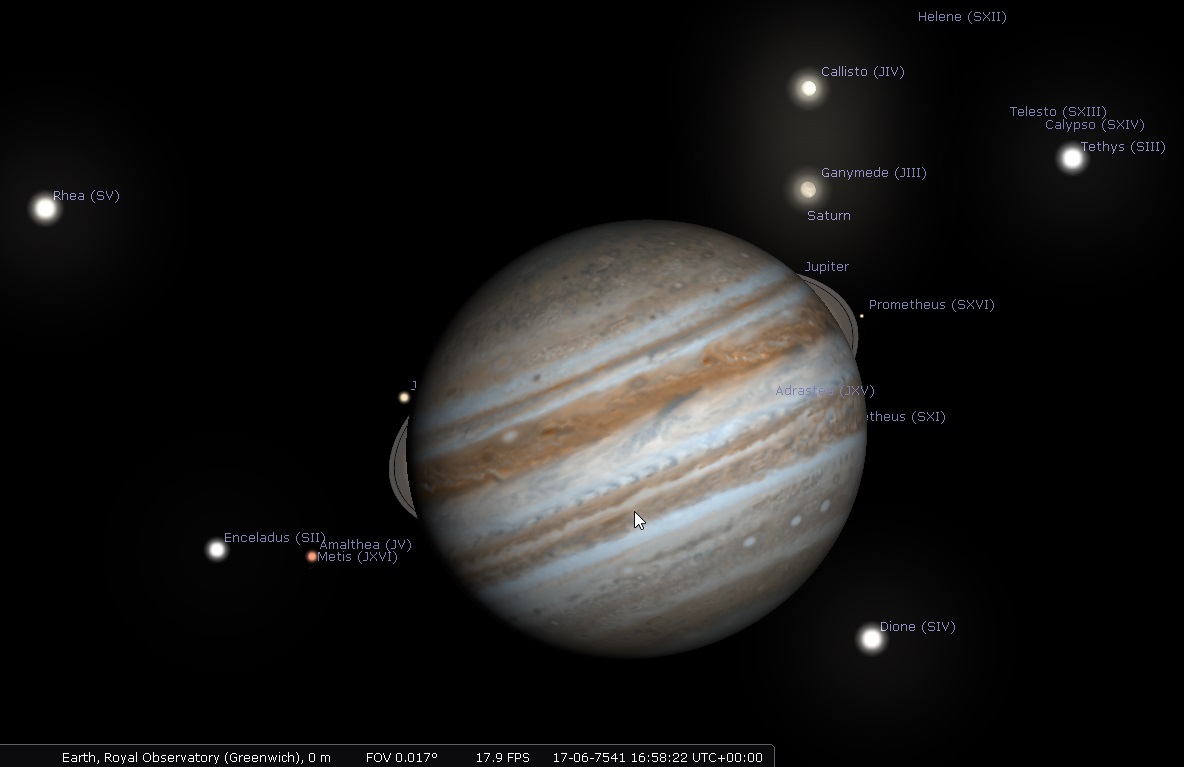
A conjunction of Jupiter and Saturn in 7541.
Vitagliano pointed out that there was and will not be any such occultation inbetween, making them truly rare events. There also is something we may be able to see in November 2039; almost a year before the next close conjunction of Jupiter and Saturn Venus will be seen between them. Also the moon (49% illuminated) and Mars will be present then, but that can only be shown by even further distorting the view. A nice extra is that also Uranus will be present then, althought it cannot be seen without aids.
When playing with the files to find interesting events, especially taken into account should be the elongation, the distance from the sun in degrees, which preferrably should be more than larger than 25 degrees. That is regardless of a plus or minus sign; a negative elongation means that planets close to the sun rise before the sun, as in June 1821, while a positive elongation means that they set after sunset, as in December 2020. Yet the 25 degree limit should not be taken too absolute, in any case not for multiple conjunctions, when more than two planets are involved. Also important is that the maximum distance between the planets should not be too large, and the fact that Mercury does not contribute much if you just want to enjoy the view.
A very impressive sight was the quintuple conjunction on 13 May 2002; I remember having seen all five planets, but I do not recollect how well I could see Mercury. The moon was just new and hardly visible. Some perhaps interesting events in the near future, as seen from the Netherlands, will be Venus, Jupiter and Saturn in December 2021, Venus, Mars and Saturn in March 2022, and a multiple conjunction of Mars, Saturn, Venus and Jupiter, with the latter two very close together in May 2022.* Minimal distance cannot be seen, but also at times close to it there will be impressive views, if the weather permits. Especially for the latter two conjunctions the altitudes will be small; there thus are other locations with more favourable conditions to see these conjunctions. The freely available planetarium program Stellarium will be of great help in finding them. -- end of update
* The for me most impressive conjunction was that of Venus and Jupiter on 23 February 1999. Around 19h (UTC+1) we came back from the funeral of my sister-in-law Trees Sarkol (1957-1999), and walking to the family home in Neer, Limburg, Venus and Jupiter stood low in the west, as I rembered it perfectly horizontally aligned, the evening already very dark. I had not known about it beforehand, and it felt very symbolic for all of us.
The screenshot shows the limitations of simulation: I vividly remember Venus and Jupiter next to each other as very bright spots, perfectly separated, and no halo. In the simulation they melt together, brightness being shown by the size of the dots. This screenshot therefore is completely correct, but it does not show what it looked like. On the positive side, it thus is very well possible that the conjunction of Venus and Jupiter in May 2022 will be a more impressive view than it seems to be in the screenshots.
Women and the Apollo 11
—
13 October 2020
Today, our 2019 article for Hamilton Day, How a 19th century Irish mathematician helped NASA into space, was retweeted. But it was apparently not too clear that we had argued that there were no quaternions in the Apollo program, that they had entered space travel and exploration for the first time in the Space Shuttle Program, so there was a second tweet, that it should be noted that so far we had not found any evidence for quaternions in the Apollo code.
When in preparation for our article I had been searching for information about the Apollo program, I of course did online searches including the search word Hamilton, and found the story of Margaret Hamilton, of whom I had never heard. Intrigued by the story of the women in the Apollo program, the
state of science then, and having seen the film Hidden figures, I made a short presentation for my astronomy club. Of course that had to contain nice pictures, and then I found something.
It is often claimed that in the “firing room” at Kennedy Space Center, when the Apollo 11 was launched, there was only one woman in the room, JoAnn Morgan. She was the first female engineer at Kennedy Space Center, and thereafter became the first female senior executive at the Space Center. She thus indeed was the only female engineer in the firing room on 17 July 1969, but she was not the only woman in the room.
In the larger photo two other women can be seen, and perhaps three. In the cutout below, towards the lower left corner is JoAnn Morgan, and towards the upper right corner the two or three women can be seen standing. Of course, these women probably did not have a direct task during launch, but ‘you and I’ would not have been allowed to be there. So now I am very curious, who were they, and why were they there? If any one has information, knows whether the person standing to the right of the two women is also a woman, or perhaps recognizes more women in the room, I would be very happy to be contacted about it.

Three or four women in the Apollo 11 Firing Room at Kennedy Space Center
Two physics essays

TeleportationAbout how to teleport using quantum entanglement. But perhaps in a hundred years computers can just store us on a hard drive and we can be rebuilt from that, evading the no-cloning theorem. I would greatly prefer teleportation.

T4T and the curious Higgs particleAbout particle physics and why the Standard Model needed the Higgs boson. To my happiness, when I had almost finished writing the Higgs boson was found. This essay originally having been written in
Dutch, I finally found time to translate it.
When, in 2014, I stumbled on Hamilton’s bizarre reputation I was, next to my work in the university library, studying physics. I wanted to become a cosmologist, and as many students do, I hoped to make a great discovery some day, or if that would not happen, at least a tiny one. Little had I expected what ‘my discovery’ would look like, and how much it had nothing to do with the universe. Still, as a variation on what Isaac Asimov seems to have said about crying out “Eureka” or mumbling “that is funny,” it appeared that thinking “that is odd” can also ‘herald’ years of work.
It happened when I was enrolled in the first course for my masters, History of Vector Analysis. I then heard about Hamilton as an alcoholic, who had married some ‘lass’ from across the fields just to be married, and after his discovery of quaternions only had eye for them for the rest of his life (however useful that was). I vividly remember the picture I had formed in my mind, of a man looking at beautiful sloping green fields from behind his desk but seeing nothing but quaternions. I also remember that I wondered when he drank all that alcohol, perhaps in the evening, still sitting at his desk, and that I pitied that poor lonely village girl. Until I read about Hamilton’s suprisingly peaceful description of the walk with his wife along the Royal Canal where he had his Eureka moment. I then imagined that thinking “Woman, go away again and leave me in peace instead of annoying me even on my quiet walk along this canal” would most likely have prevented any Eureka moment. It was the start of a two weeks’ frenzy filled with sudden realizations, “Impossible! That is simply utterly illogical!” Thereafter, no physics for me any more; reputations, gossip, Victorian times and the difficult lives of married Victorian women kept me busy for years.
Every now and then I give a presentation about the subject I had chosen in the bachelor cosmology seminar I had been enrolled in before receiving my bachelor’s degree. The subject had been the ‘inflationary universe,’ and I adapted and extended my bachelor’s presentation to an evening presentation for local groups of the KNVWS, of which I am a member. When I had finished writing about Hamilton what I had thought I had to write, and again was invited to give my presentation, I was very happy to be back in the universe. But knowing that continuing my studies is not in any way realizable in the near future, I also started to think that perhaps I do not want to become a cosmologist any more; I am, as we say, “not twenty any more.”
Already from the first time I gave my presentation about the inflationary universe I have introduced myself by telling the audience that I do not believe inflation can be true, but that I am very happy to explain the theory to them, including why the problems with the Big Bang theory seemed to be solved so neatly. Also, that I obviously cannot prove that inflation is not true, yet that it just does not make much sense to me. But what happened while I was working on Hamilton’s reputation was that I became more convinced that Erik Verlinde* may be right (and not just because the first course in relativity I was enrolled in was given by him :). I can proudly say that already before handing in my bachelor’s essay (August 2013) I told my mentor that if I had money (which I do not have) I would bet on Verlinde’s theory, against inflation. So I figured that instead of becoming a cosmologist myself it would be better to try to learn to explain his theory to my fellow KNVWS members. Some people do that very well already, but it would give me focus.
But that will also take much time, and therefore my brother Rein thought that in the meantime it would be a nice idea (as a consolation for lost physics?) to also make a BookReader for my bachelor physics essays, which I once did love to write. One of them, an essay on Teleportation, is now in the BookReader even though it is obviously not a book, and some day I will also add my bachelor’s thesis, about relativity, which should have formed a diptych with my master’s thesis; it must be rewritten into an independent whole because I will not write a master’s thesis about inflation any more. I look forward to immersing myself into relativity again and rewriting that essay.
Teleportation is about how teleportation could work in theory, but also, however much I would prefer Star Trek-like teleportation I argue that if, or when, our computers become powerful enough (at the time of writing, 2010, the year 2096 seemed reasonable), perhaps teleportation is not necessary any more because we then can just store all our data, have it sent to where we want to go, and then be reassembled again. That is not as unthinkable as it now may seem; who would have thought in say the 1970s that you could receive a letter from a friend almost instantaneously without even knowing where on earth (literally) that friend is. And since the covid-19 pandemic we have quickly learned to even skype/zoom/etc. without knowing where the person is we are talking to. But there is one problem; having sent your own configuration to some planet and be reassembled again would circumvent the ‘no cloning theorem’ of quantum mechanics, giving our descendants some very difficult issues to deal with.
I now also translated an essay I wrote in 2012 when following a course in particle physics, T4T and the curious Higgs particle, originally in Duch, but while translating I made many corrections. It is about the Standard Model of particle physics, about forces and fields, real and virtual particles, and why the Higgs boson was necessary. It is aimed at the interested layperson; I left out everything I could not explain in about thirty pages. I tried to make the Dutch and the English version as similar as possible, which was also just fun to do.
There were some surprising coincidences. While writing the original essay in 2012 the Higgs boson was found 😃, and while translating it in 2020 Seti@home stopped after 21 years 😢. That project was the first of what now is called ‘citizen science’ that I participated in, and thereafter I joined quite some BOINC projects. One of these projects was T4T@home,** which became the incentive to choose the Higgs boson as a subject when I had to write the essay, as can be read in the preface.
And something seems to be wrong in the Seti@home’s WikiPage. It is written there that Seti@home started on 17 May 1999, which would mean that I joined already the next day. That would need many coincidences: the salesperson then must have joined the same day or one day after it started, and I then talked with him the same or the next day. That seems to be extremely improbable. So I started a search, reasoning that someone having joined very early could now have very much credit. It was a wild guess but I found that the present number one is from the Class of 29 April 1999. So whenever it started, it was earlier than the WikiPage claims. But I do seem to have been one of the first, thanks to the salesperson in ’s-Hertogenbosch. Nice. (Later: I have made a remark about this on the talk page of the Wikipedia article. I am curious if someone will know or find what the date of the very first class was.)
* I was curious about Schrödinger’s remark, “I daresay not a day passes - and seldom an hour - without somebody, somewhere on this globe, pronouncing or reading or writing or printing Hamilton’s name,” and whether that still holds. As an admittedly rather skewed sample I looked at the 71 articles of which Erik Verlinde was author or co-author and which were open access, as remarkably most of them were. And indeed, the Hamiltonian was mentioned in 34 articles.
** The original posts by the LHC@home 2.0 team about Test4Theory@home, the “rogue” systems and the team having been “flabbergasted” as mentioned in the Preface, can be found at the BOINCstats/BAM! page for vLHCathome including links to the original articles. I had paraphrased the LHC@Home 2.0 Team’s first post of 11-08-2011, but it is too historical not to write it out once more: “WE HAVE A PROBLEM. WE BELIEVE SOME “ROGUE” SYSTEMS ARE SUCKING OUR QUEUES DRY AND THUS OVERLOADING THE SUPPLY OF JOBS TO EVERYONE ELSE. Please be patient - we will try to fix this as soon as possible. Until this problem is understood, we have disabled the creation of new jobs and users for the moment. As soon as the system is recovered, the work unit flow will be restored.”
This is the 11 August 2011 BBC article calling on volunteers, LHC@home allows public to help hunt for Higgs particle. How appealing can you be! No wonder the servers were overloaded (even if everyone, including me, had understood the need for VMs and thus not crashed the first work units). The BBC article linked to the LHC@home home page, but the link to the T4T page containing the quotation I used, “The Test4Theory@home project seeks to engage volunteers in theoretical physics computations for the Large Hadron Collider at CERN,” does not exist any more but happily, it still is visible in the Wayback Machine, About Test4Theory. The capture being of the page as it was two years later, it also contains the later warning: “Before Attaching to us you must first have an up to date installed version of the VIRTUAL BOX software package. To download Virtual Box if needed see instructions here”.
Nowadays my computers are calculating at a very quiet but steady rate,

Images I liked but which disappeared from the web
—
November 2022
These two images were once easy to find on the web, but in time they disappeared. Because Google states that images cannot be found if they are not mentioned on a website, I thought to just place them here.

“Excuse me! I have a system to destroy!” by ‘Contra’
The first is a painting on a wall in Utrecht. I do not know who painted it and when, but it existed until 2004. I had shown it on a previous webpage but I archived it, and the image disappeared from Google searches.
When in 1999 I started my physics studies in Utrecht I still lived in 's-Hertogenbosch, and while travelling by bus, then line 12, from Utrecht Centraal to the Uithof, we passed by this graffiti. After some years I started to think that it actually belonged in a museum, in an overview of striking street art. And then it was destroyed. People had already drawn around it, which was apparently mended every time as can be seen on the photo, until, on some miserable night, someone completely ruined it. But instead of restoring it, it was painted over, and nothing reminds of it any more.
I was unhappy about not having photographed it when I started a search, and to my amazement I found a thumbnail of it on the website of Michelle Teran, who apparently liked it as I had done. I contacted her, and she sent the photo in a somewhat larger format. I was happy to see it again.

Little Fellow
The other one is ‘Little Fellow’ by The Light Works. When in 2012 I bought a new laptop, I decided to throw the pre-installed Windows off and change to CentOS, a choice I am still very happy with. I now have a Windows laptop, an Ubuntu computer, and that CentOS laptop; if I really want something one of my computers can do it, and LaTeX is the most easy to do on CentOS.
2023: Unfortunately, it was bought by Red Hat; I now run the last version in a Virtual Box. Something I had happily encountered when I encountered T4T@home.
Once, on the boat to England, I was searching for a nice wallpaper for my CentOS laptop and found The Light Works’ ‘Little Fellow’. Since then he looks at me when I start up my laptop, at least when he is not obscured by too many desktop icons. But when lately I searched for him online I could not find him any more; therefore I place him here.
Making paper books searchable: the Search Tag©
Copyright 2017, Anne van Weerden
—
17 December 2020
With the coming of the ebooks, many people expected that paper books would disappear. They did not.
It appeared that people who want to work out of a book, needing only a few sentences or little parts, prefer ebooks because they can easily be searched. But in case a book is going to be read cover to cover paper books are highly preferred. Paper books are also preferred by people who want to feel and smell the book, or in case the book is full of symbols which are hard to search for, or when many little parts on different pages are used at the same time, as in case of mathematics or physics books. It also appeared that students remember texts from a paper book better than from an ebook.
Still, even in the cases in which they are preferred, it is a problem that paper books are not searchable. For instance when you are in a bookstore or a library, looking for a book containing something very specific such as one special sentence you remember; such a search could cost hours. Or, when you are reading a detective while sitting lazily on your couch, and suddenly you realize that someone said something which could be a clue, but you do not remember who or when.
Of course, you can try to find sentences or quotes on the internet, but then the atmosphere you were in is lost, whether you were studying hard or you were captivated by the story. Moreover, if it is an older book there is a good chance that it is not in the public domain, and you end up searching, in vain, as long as when you would have searched in the book itself by turning its pages.
Search Tag
To make paper books searchable, Search Tags can be added to the books. There is nothing new about having tags in books; library books have security tags which react when you, accidentally of course, leave the library without having borrowed the book.
A Search Tag for a specific book contains all the metadata of the book, and its content ordered by page number. The tag can only send metadata and page numbers to a “Search Tag app” on your mobile, or perhaps on some other gadget containing the app, such as a book ribbon with a nice, small and flexible keyboard and display which comes with the book.
Having downloaded the Search Tag app, when you are standing before a collection of books, in a bookstore or a library, and would like to know if something specific is in one of the books, you open the Search Tag app, and type in some search words, or (part of) a sentence. The books containing the search words then send you their Author, Title, Year, and the numbers of the pages containing the search result. You indeed can receive answers of many books at once.
Or when you are sitting cosily on the couch reading a detective, and you start to suspect that the butler committed the murder, you can use your phone or the book ribbon to search in earlier pages. You do not have to go to the internet with all its distractions such as a new interesting message, or worse, accidentlly stumbling on a spoiler; you just see pages where your answer might be found, allowing you to happily discover that you were right without having lost the bond with your book.
Tagging and copyright
Tagging the paper books is of course very easy for new books because the publishers can add the Search Tags, but also earlier paper books can be tagged, when scanned and OCRred. It is allowed for libraries to scan their own books even when they still are under copyright, as long as the scans remain behind the library proxy.
Using the Search Tags in the library, which is after all more or less a public space, does not lead to copyright issues because the tags cannot be hacked; they do not send the text, only page numbers, and they can be programmed in such a way that they stop reacting in case something is altered in the way they are approached. Moreover, having some limited range the tags are in fact a property of the book itself; they can only communicate with the Search Tag app when that is in the vicinity of the paper book.
Extra advantages
Having scanned the books to be able to make the Search Tags, to further bring paper library books into the digital world by making the books appear in internet searches, small parts of the scans which are made for the tags can be put on the library’s websites, for instance containing the table of contents, a part of the first chapter, and the bibliography. And if server capacity is a problem, these parts of the scans can be sent to Google Books where it is customary to show books that way.
Scanning many more library books would be in any case a very good idea; I have regularly found new books by authors who were apparently completely oblivious of some earlier work about that subject, simply because these books are not online, and not available in libraries the authors know or can visit. I am worried about very many good books between the 1930s and 2000; they exist on some shelves as they always did, but at the same time they have disappeared from sight because we all search digitally now. So scanning them and tagging them would finally bring them into the digital world without losing their individuality as paper books.
A plea for digitally opening up paper books on library shelves should also be made when realizing that these books were all selected by hand, as worthy to become a library book. In the paper days books were never bought in packages; each book was selected and paid for. That alone should make it important enough to scan them all.
There would also be other advantages. Inter Library Loan is often a problem; even though a library is willing to send some book to someone’s library, there are many books not yet in the public domain about which the library is not willing to take the risk of no return, or the books are in no condition to be sent around the world.
If libraries thus make a database of the original scans of their own books they can put that database behind the library proxy, which is allowed in any case in Europe, and open them the moment the book enters the public domain. In the meantime, while they still are in copyright, people can loan the scans through ILL in the same way as books can now be read on ebook platforms. No more paper books will have to be sent unless in special occasions.
The Search Tag and deadlines
A last, very important reason to introduce the Search Tag in the academic world are the time consuming searches for very specific quotes to be used in new paper books or articles. Especially when you have deadlines.
When we started to write our gossip article about Hamilton, my co-author had asked me to prove what I was claiming, namely that the contemporary view on Hamilton’s private life is almost completely built on on the 1866 story by his eldest son William Edwin Hamilton, mixed with the criticisms of Hamilton’s main biographer, Robert Graves. Steven specifically asked me to find six books in the library which were spread over the years and contained new gossip, in order to quote them literally. It took me many hours to find them. I had to guess whether Hamilton would be mentioned, take the book from the shelf, search the index, search the pages, judge, and in most of the cases put it back. The books being from throughout the 20th century, in hindsight some of them were searchable on the internet, but not after I already knew what the quotes were. Others were completely closed.
That also held for Hankins’ biography; it is not searchable online unless you have an Amazon account, which you can only acquire by buying a book from them, for which you need a credit card which I do not have. While writing my AVM I had borrowed the library copy of Hankins’ biography, and a number of times I had to search for over an hour. For instance when I wanted to use a sentence but Hankins had mentioned it in a different chapter than the one I expected it to be in. Graves’ biography was on the Internet Archive and therefore searchable, and the difference between them had made me wonder why it had to be so difficult.
The later long search in the library made me wish for a way to look into the books without having to take them from the shelves, and that is where the Search Tag idea saw its first light.
Making this a reality
Unfortunately I do not have any means to convert this idea into reality, so I figured to describe it here. If any one thinks this is a good idea, please contact me.
Nederlandse samenvatting van
A Victorian Marriage : Sir William Rowan Hamilton

William Edwin, Archibald Henry and Helen Eliza Amelia,
as depicted on p. 17 of the essay. See for the descriptions, the suggestion that the boy on the first row is most likely William Edwin, and where the photographs came from, pp. 18-24.
Lady Hamilton around 1855

Lady Hamilton (1804-1869)
This is the larger picture as reproduced from Wayman’s 1987 book about Dunsink Observatory. Lady Hamilton was said to have been fashionable rather than intellectual, and her fashionability seems to show in this photograph. Unusual for pictures from those times is her faint smile; she looks as if she found being photographed rather funny.
Lady Hamilton around 1860

Lady Hamilton (1804-1869)
This is a photo of a photo kept at Trinity College Dublin Library; some blots on her face have been removed here. The glass of the frame is broken. Lady Hamilton’s left hand is vague, perhaps she moved it while the photo was taken. It is remarkable that apparently someone put the photo in a frame looking exactly like that of Catherine’s drawing. Courtesy Trinity College Dublin Library.
Two times Catherine Disney
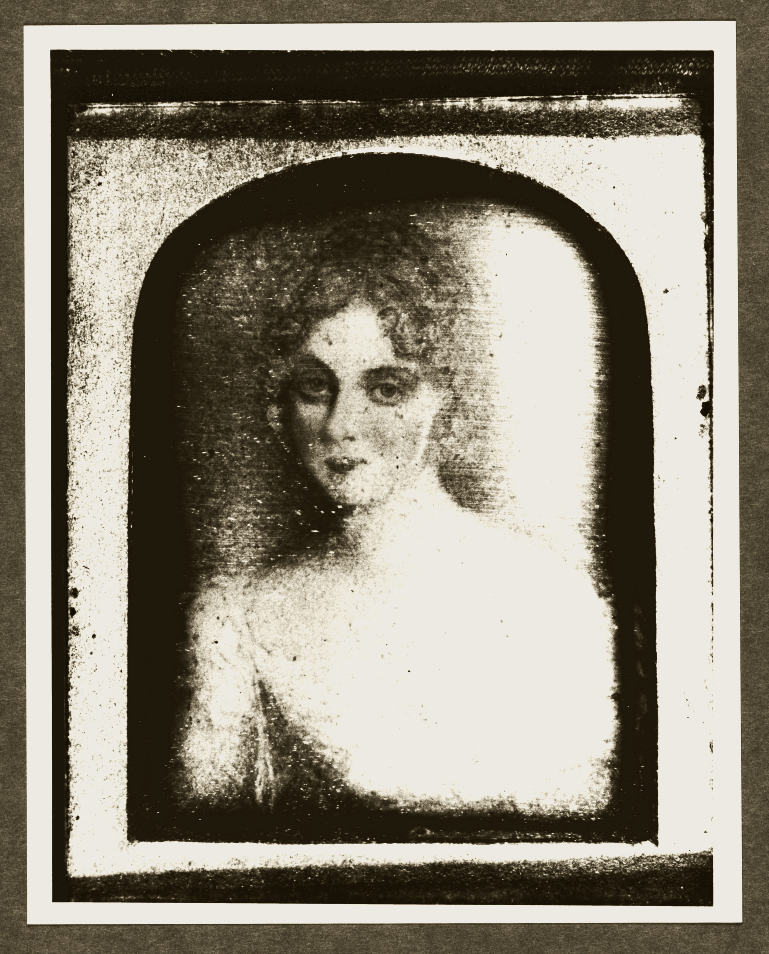
Catherine Disney (1800-1853)
This is the larger picture of Catherine Disney. It is a photo, made by Trinity Libary, from an earlier photo from either a miniature or a portrait from before 1825. Either the earlier photo or the portrait was damaged, therefore the right part of Catherine’s face has been modified. The photo was “attributed as being Catherine Disney” and that this attribution is correct is almost beyond doubt; the portrait is in complete agreement with Hamilton’s lines about Catherine’s “locks of gold, and soft blue eyes, and cheeks All rich with artless smiles and natural bloom.” Courtesy Trinity College Dublin Library.

Catherine Disney (1800-1853)
This is the larger picture of the second portrait of Catherine Disney. It was shown in Disneys of Stabannon by Hugh Disney, courtesy Dr Patrick Wayman. Just as in the other portrait Catherine looks very young, here probably even younger, it may have been made between 1815 and 1820. The image in Disney’s book was very pixelated, the portrait can therefore not be given in more detail. It remains doubtful which one of these portraits was copied, in 1854, from the miniature and which one was the better portrait Hamilton had received from Louisa Disney (Hobson, Reid) in 1861; for both possibilities arguments can be found.
The book about Catherine Disney is ready for some time, and now I realize that I am happy that it is finished. It was difficult to immerse myself in such a sad life for such a long time. How it must be to be forced to marry against one’s will is almost unfathomable for any one who is free to choose; it should just not be possible anywhere.
Dunsink Observatory

Dunsink Observatory and the South Dome by Sir Robert Ball, one of Hamilton’s successors Reproduced from
The book of Trinity College, Dublin, 1591-1891. Belfast: Marcus Ward & CO., Limited.
https://archive.org.
A date is not given but the South Dome, which can be seen on the left, was built in 1865, while the book was published in 1892. The light, which in Hamilton’s time would have come from candles and fires in the fireplaces, streaming through the windows beautifully indicates the atmosphere within the Observatory and on the premises as it must have looked like when the Hamiltons were at home and still awake; Hamilton working on his mathematics or talking with his family, and Thompson observing in the dome. The soft light shining from the left on the lawn, and on the left side of the Observatory, its south side, seems to indicate moonlight, probably even a full moon.
Hamilton around 1861
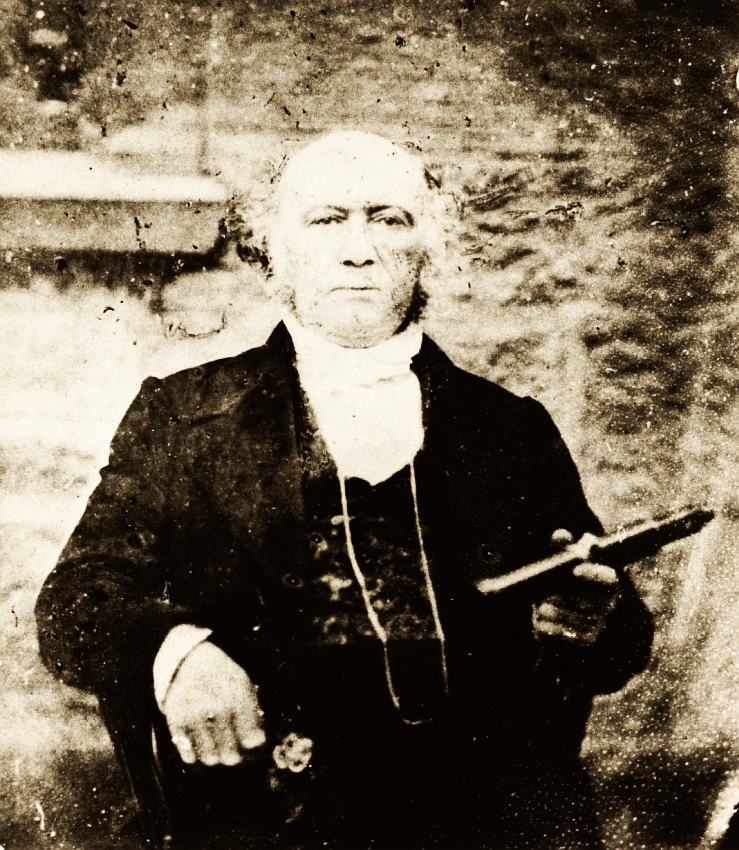
Sir William Rowan Hamilton around 1861 This is the larger picture as it was shown in “What is Life? Celebrating Erwin Schrödinger.”
Manuscripts at Trinity College Dublin, but with the adaptations I made, as shown below. I still did not fins how to center there photos.
Comparisons
Sir and Lady Hamilton
Having removed some blots on these photos, and having made an effort to restore the parts of especially Hamilton’s face which were covered by the blots, the original and the altered ones are shown together. Using the mouse, move the brown dot to the right to see the blotted photos. For background information, see this entry.
Compared using Image Comparison Slider. I did not find yet how to center the images.
Hamilton and his daughter Helen in 1859
—
Summer 2020
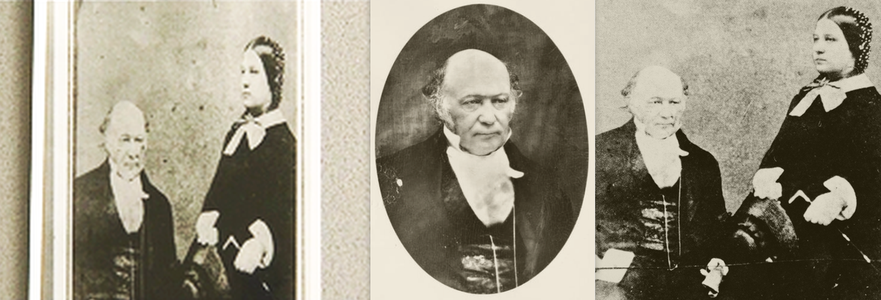
The photos on the left and right side show
Hamilton and his daughter Helen Hamilton. Yet the woman is often said to be Hamilton’s wife Helen née Bayly. That is incorrect (as are some other remarks on the page containing the left photo); the woman is clearly much younger than Hamilton. According to Graves
the photo was taken in Fulneck, and the woman is Hamilton’s daughter, Helen Eliza Amelia. The original photo is on the right, as given in
Hankins’ biography, who indeed erroneously stated that it is Helen Bayly. The photo in the middle is a part of it, the most well-known picture of Hamilton, given as a
frontispiece to the second volume of Graves’ biography. It obviously was slightly rotated counter clockwise to give it a more energetic expression.
It is quite difficult to imagine that the photo in the middle is the same as the left side of both the left and the right photo. The photo in the middle is rotated counter clockwise a little, making Hamilton look slightly different, yet from the details it is clear that it indeed is the same as the left part of the other two photos. That the woman is Hamilton’s daughter Helen Eliza Amelia is known from the description given by Graves. Helen had been ill for long time already, and “at the end of July [1859] Hamilton escorted his daughter, still an invalid, to stay for some time with the Keating family, relations on her mother’s side, at Rhyl, in North Wales. In the beginning of September he carried her off from these kind friends to become the guest of his own maternal relations, Mr. and Mrs. Joseph Willey, at Fulneck, the Moravian settlement near Leeds. Here she was to remain while he attended the Meeting of the British Association at Aberdeen.
“[After the meeting having made various visits,] to rejoin his own daughter at Fulneck was now his aim, and at this Institution he again spent some days, the principal incidents of which were his giving a Lecture on Astronomy to the youthful pupils of both sexes (from whom letters of thanks were addressed to him), and by his sitting, with his daughter standing at his side, for the photographic likeness from which an autotype reproduction has been placed as a frontispiece to the second volume of this work. [...] Hamilton had now the happiness of recognising that the visits in England of his beloved child had been attended by the wished-for result, and in restored health she accompanied him on his return to the Observatory at Dunsink.” But Hamilton in the meantime had heard that his friend John Pringle Nichols had died, and it seems to show that he had been very tired from the meeting and the visits afterwards. Travelling in those days was not easy indeed.
Inbetween Graves had made a remark about the middle photograph, which he chose as a frontispiece in his biography, “And here I take the opportunity of expressing my opinion that this representation of his features stands out from all other photographs of him which I have seen (and I believe I have seen almost all that were taken), as alone doing something like justice to the combined intellectual and moral character of the subject. It exhibits, I think, both in conformation and expression, the profound thinker, the reverent benevolent sage.” Not many photos of Hamilton having been made, this will indeed be the reason that this is the most famous photo of Hamilton.
Published in the Dublin Penny Journal, about ten days before Hamilton’s wedding, “We present our readers with a portrait of a singularly large bird, a variety of the Swift, which was caught in the neighbourhood of Rathfarnham in the month of February, 1832. From its great sweep of wing, as well as the circumstance of its appearing at a time of the year when swallows are rarely, if ever, to be seen, it was at first supposed to be a hawk by a boy who perceived it flying about. He pursued it to an outhouse, into which it had flown, but was too late to rescue it unhurt from the murderous talons of a cat that had seized it, as it died soon afterwards. Its colour is exactly that of the common Swift; and the spot on the throat of the same dirty white, but rather larger, and much more distinctly and better marked. Its mouth is considerably larger than even that of the night-jar, or goat-sucker, of the same tribe; it extends far back, quite beneath the eye. The quill feathers of the wings, as well as those of the tail, are very pointed. The tail, which consists of ten feathers, is remarkably different from that of the common swift, the feathers being all nearly of an equal length. This bird measured ten inches [25 cm] from the point of its bill to its tail, and twenty-one inches [53 cm] from tip to tip of its wings. It is preserved in the fine collection of Irish birds of T.W. Warren, Esq.”
February 2023:
Someone suggested that it could be an alpine swift, an indeed very large species of swift. And then it was quite easily found. Both in Our Summer Migrants and A history of British birds the bird was described as having died in Rathfarnham in 1833. That the bird was killed in 1832, as was written in the Dublin Penny Journal, seems illogical indeed; the issue mentioning this swift was that of 30 March 1833. And although in the article there is no mention of its white underbelly, the remark about the pointed feathers of the tail, “all nearly of an equal length,” is easily recognised in this photo.



